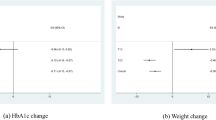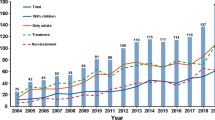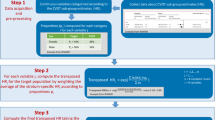Abstract
Recruitment for pediatric trials in Type II Diabetes Mellitus (T2DM) is very challenging, necessitating the exploration of new approaches for reducing the sample sizes of pediatric trials. This work aimed at assessing if a longitudinal Non-Linear-Mixed-Effect (NLME) analysis of T2DM trial could be more powerful and thus require fewer patients than two standard statistical analyses commonly used as primary or sensitivity efficacy analysis: Last-Observation-Carried-Forward (LOCF) followed by (co)variance (AN(C)OVA) analysis at the evaluation time-point, and Mixed-effects Model Repeated Measures (MMRM) analysis. Standard T2DM efficacy studies were simulated, with glycated hemoglobin (HbA1c) as the main endpoint, 24 weeks’ study duration, 2 arms, assuming a placebo and a treatment effect, exploring three different scenarios for the evolution of HbA1c, and accounting for a dropout phenomenon. 1000 trials were simulated, then analyzed using the 3 analyses, whose powers were compared. As expected, the longitudinal modeling MMRM analysis was found to be more powerful than the LOCF + ANOVA analysis at week 24. The NLME analysis gave slightly more accurate drug-effect estimations than the two other methods, however it tended to slightly overestimate the magnitude of the drug effect, and it was more powerful than the MMRM analysis only in some scenarios of slow HbA1c decrease. The gain in power afforded by NLME was more apparent when two additional assessments enriched the design; however, the gain was not systematic for all scenarios. Finally, this work showed that NLME analyses may help to reduce significantly the required sample sizes in T2DM pediatric studies, but only for enriched designs and slow HbA1c decrease.



Similar content being viewed by others
References
Sun H, Temeck JW, Chambers W, Perkins G, Bonnel R, Murphy D (2017) Extrapolation of efficacy in pediatric drug developmentand evidence-based medicine: progress and lessons learned. Ther Innov Regul Sci 2017:1–7
Nadeau KJ, Anderson BJ, Berg EG, Chiang JL, Chou H, Copeland KC, Hannon TS, Huang TT, Lynch JL, Powell J, Sellers E, Tamnorlane WV, Zeitler P (2016) Youth-onset type 2 diabetes Consensus report: current status, challenges, and priorities. Diabetes Care 39(9):1635–1642
Zeitler P, Chou HS, Copeland KC et al (2015) Clinical trials in youth onset type 2 diabetes: needs, barriers, and options. Curr Diab Rep 15:28. https://doi.org/10.1007/s11892-015-0597-2
Cefalu W (2013) Today reflects on the changing “faces” of type 2 diabetes. Diabetes Care Care 36:1732–1734
TODAY Study Group, Zeitler P, Hirst K, Pyle L, Linder B, Copeland K et al (2012) A clinical trial to maintain glycemic control in youth with type 2 diabetes. N Engl J Med 366:2247–2256
Barrett JS, Bishai R, Bucci-Rechtweg C, Cheung A, Corriol-Rohou S, Haertter S, James A, Kovacs SJ, Liu J, Potempa D, Strougo A, Vanevski K, for the IQ consortium -, CPLG, Pediatric Working Group (2018) Challenges and opportunities in the development of medical therapies for pediatric populations and the role of extrapolation. Clin Pharmacol Ther 103(3):419–433
Guidance for Industry, How to Comply with the Pediatric Research Equity Act, DRAFT GUIDANCE, U.S. Department of Health and Human Services Food and Drug Administration, 2005. https://www.fda.gov/downloads/drugs/guidancecomplianceregulatoryinformation/guidances/ucm079756.pdf
Regulation (EC) No 1901/2006 of the European Parliament and of the Council of 12 December 2006 on medicinal products for paediatric use. https://ec.europa.eu/health/files/eudralex/vol-1/reg_2006_1901/reg_2006_1901_en.pdf. Accessed 6 Nov 2014
Framework for FDA’s Real-World Evidence Program, December 2018, https://www.fda.gov/media/120060/download
Davidian M, Giltinan DM (2003) Nonlinear models for repeated measurement data: an overview and update. JABES 8:387–419
Mallinckrodt CH, Lane PW, Schnell D, Peng Y, Mancuso JP (2008) Recommendations for the primary analysis of continuous endpoints in longitudinal clinical trials. Drug Inf J 42(4):303–319. https://doi.org/10.1177/009286150804200402
Lane P (2008) Handling drop-out in longitudinal clinical trials: a comparison of the LOCF and MMRM approaches. Pharm Stat 7:93–106
Karlsson KE, Vong C, Bergstrand M, Jonsson EN, Karlsson MO (2013) Comparisons of analysis methods for proof-of-concept trials. CPT: Pharmacomet Syst Pharmacol 2(1):e23. https://doi.org/10.1038/psp.2012.24
Lenters-Westra E, Schindhelm RK, Bilo HJ, Groenier KH, Slingerland RJ (2014) Differences in interpretation of haemoglobin A1c values among diabetes care professionals. Neth J Med 72:462–466
Ristic S, Collober-Maugeais C, Pecher E, Cressier F (2006) Comparison of nateglinide and gliclazide in combination with metformin, for treatment of patients with type 2 diabetes mellitus inadequately controlled on maximum doses of metformin alone. Diabet Med 23:757–762
Heisler M, Vijan S, Makki F, Piette JD (2010) Diabetes control with reciprocal peer support versus nurse care management: a randomized trial. Ann Intern Med 153(8):507–515
Gross JL, Rogers J, Polhamus D et al (2013) A novel model-based meta-analysis to indirectly estimate the comparative efficacy of two medications: an example using DPP-4 inhibitors, sitagliptin and linagliptin, in treatment of type 2 diabetes mellitus. BMJ Open 3:e001844. https://doi.org/10.1136/bmjopen-2012-001844
Gibbs JP, Fredrickson J, Barbee T, Correa I, Smith B, Lin SL, Gibbs MA (2012) Quantitative model of the relationship between dipeptidyl peptidase-4 (DPP-4) inhibition and response: meta-analysis of alogliptin, saxagliptin, sitagliptin, and vildagliptin efficacy results. J Clin Pharmacol 52(10):1494–1505
Core Team R (2008) R: A language and environment for statistical computing. R Foundation for Statistical Computing, Vienna, Austria
Morris TP, White IR, Crowther MJ (2019) Using simulation studies to evaluate statistical methods. Stat Med. https://doi.org/10.1002/sim.8086
Pinheiro J, Bates D, DebRoy S, Sarkar D, Core Team R (2018) nlme: Linear and Nonlinear Mixed Effects Models. R Packag Vers 3:1–137
Comets E, Lavenu A, Lavielle M (2017) Parameter estimation in nonlinear mixed effect models using saemix an R implementation of the SAEM algorithm. J Stat Softw 80(3):1–41. https://doi.org/10.18637/jss.v080.i03
SAS version 9.4. SAS Institute Inc., Cary, NC
Mandema J, Sweeney K, Terra S, Sahasrabudhe V (2012) Model-based Meta-analysis of the HbA1c Lowering Effect of PF-04971729, a Sodium Glucose Co-transporter-2 Inhibitor (SGLT2i), in comparison to other SGLT2i and anti-diabetic agents (ADA). Poster available on https://www.certara.com › Resource Library
Samtani MN (2010) Simple pharmacometric tools for oral anti-diabetic drug development: competitive landscape for oral non-insulin therapies in type 2 diabetes. Biopharm Drug Dispos 31:162–177
Acknowledgements
The authors thank their colleague from Sanofi Ashley Strougo for her sound advice.
Author information
Authors and Affiliations
Corresponding author
Ethics declarations
Conflict of interest
The authors are full-time Sanofi employees. They declare no conflict of interest.
Additional information
Publisher's Note
Springer Nature remains neutral with regard to jurisdictional claims in published maps and institutional affiliations.
Rights and permissions
About this article
Cite this article
Rigaux, C., Sébastien, B. Evaluation of non-linear-mixed-effect modeling to reduce the sample sizes of pediatric trials in type 2 diabetes mellitus. J Pharmacokinet Pharmacodyn 47, 59–67 (2020). https://doi.org/10.1007/s10928-019-09668-x
Received:
Accepted:
Published:
Issue Date:
DOI: https://doi.org/10.1007/s10928-019-09668-x




